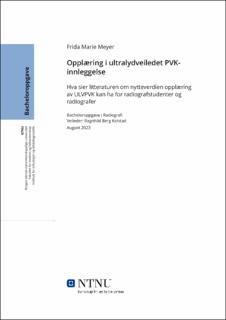| dc.contributor.advisor | | |
| dc.contributor.author | Meyer, Frida Marie | |
| dc.date.accessioned | 2023-10-05T17:23:53Z | |
| dc.date.available | 2023-10-05T17:23:53Z | |
| dc.date.issued | 2023 | |
| dc.identifier | no.ntnu:inspera:144744104:44114853 | |
| dc.identifier.uri | https://hdl.handle.net/11250/3094681 | |
| dc.description.abstract | Hensikt: Formålet med denne systematiske litteraturgjennomgangen var å sammenfatte og
vurdere vitenskapelige studier, som belyser hvordan opplæring av ULVPVK kan
gjennomføres, og hvilke fordeler og ulemper metoden kan ha.
Problemstilling: Hva sier litteraturen om nytteverdien opplæring av ULVPVK kan ha for
radiografstudenter og radiografer.
Design/metode: Oppgaven er en systematisk litteraturstudie. Tradisjonelle digitale
artikkelsøk ble gjort i databasene PubMed og Oria. Totalt ble 9 studier inkludert etter
forhåndsbestemte inklusjons-og eksklusjonskriterier.
Resultat: De 9 inkluderte artiklene var ulike typer prospektive studier, som hadde til hensikt å
følge deltakerne fremover i tid og vurdere ULVPVK-opplæringseffekt på PVK-innleggelse.
Litteraturen viser en bred enighet om at kombinasjon av teoretisk fysisk undervisning og
simuleringstrening kan gi en bratt læringskurve. Praktisk «hands-on» simuleringstrening på
fantomer kan sikre best ULVPVK prosedyretrening. Flere av studiene viste at deltakere som
gjennomførte en ULVPVK-opplæringsplan oppnådde større treffrate, og behøvde færre
innleggelsesforsøk før vellykket intravenøs tilgang ble oppnådd. Korrekt utførelse og
kompetanse forbedres med antall utførte innleggelser. Katere innlagt med ultralydveiledning
hadde en lengre varighet enn katetre innlagt med tradisjonell landemerkemetode.
Konklusjon: Studien viser at ULVPVK-opplæring og trening kan bidra til bedre treffrate,
lengre katetervarighet, mindre pasientpåkjenninger og økt tilfredshet for pasienter og
pårørende. Metoden kan også medføre økt tilfredshet for helsepersonell og helsestudenter.
Ulemper som kan oppstå ved innføring av ULVPVK-opplæring kan være risikofaktorer ved
ukorrekte prosedyreutførelse, utstyrskostnader, økt arbeidsmengde, utilstrekkelig
opplæringstid og rekruttering av kompetent undervisningspersonale. Det kan være relevant å
diskutere behovet for prosedyreopplæring med hensyn til om studentene får praktisert
ULVPVK i praksisperioder og i den kliniske arbeidsdagen. | |
| dc.description.abstract | Purpose: The aim of this systematic literature review was to summarize and evaluate
scientific studies examining how ULVPVK-training can be organized and carried out, and
which advantages and disadvantages the method may have.
Issue: What does the literature say about the beneficial value ULVPVK training can have for
radiography students and radiographers.
Design/method: This thesis is a systematic literature study. Traditional digital article searches
were performed in the databases PubMed and Oria. A total of 9 studies were included after
predetermined inclusion- and exclusion criteria.
Results: The 9 included articles were different types of prospective studies, which intended to
follow the participants forward in time and assess the effect a ULVPVK-training program had
on PVK-admission. The literature shows a broad agreement that a combination of theoretical
physical lectures and simulation training can result in a steep learning curve. Practical «handson» simulation training on phantoms can ensure the best ULVPVK procedural training.
Several of the studies showed that participants who completed a ULVPVK training plan
achieved a higher success rate, and needed fewer attempts before successful intravenous
access was achieved. Correct procedure execution and competence improve with the number
of admissions performed. Catheters inserted with ultrasound guidance had a longer duration
than catheters inserted with traditional landmark method.
Conclusion: The study shows that ULVPVK-education and training can contribute to a better
insertion successrate, longer catheter duration, less patient stress and increased satisfaction for
patients and relatives of the patients. The method can also lead to increased satisfaction for
healthcare staff and students. Disadvantages that may arise when introducing ULVPVK as a
method can be risk factors of incorrect procedure execution, equipment costs, increased
workload, insufficient training time and recruitment of a competent teaching staff. It may be
relevant to discuss the need of procedural training with regard to whether students get to
practice ULVPVK during the practical apprenticeship through school, and during the clinical
workday as graduates. | |
| dc.language | nob | |
| dc.publisher | NTNU | |
| dc.title | Opplæring i ultralydveiledet PVK-innleggelse - Hva sier litteraturen om nytteverdien opplæring av ULVPVK kan ha for radiografstudenter og radiografer | |
| dc.type | Bachelor thesis | |
